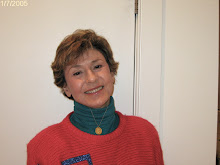Today I shall feature a different collaboration.
Lynn Moor had been a successful artist and teacher for a good number of years when, upon a visit to the Children's Museum of the Arts in New York where her daughter teaches animation, she was impressed with the artistic simplicity and the "soul" of the works that line the walls of the museum. She was moved to translate what she saw as the "creative purity of the children's art" into mosaics (I shall quote extensively from a ditty she sent me regarding her experience). She "hoped to experiment with how cut and placement and the technique of mosaic can serve to further the design and expand upon the original design, adding [her] own impressions in the process." The museum curators greeted her idea with enthusiasm and Moor committed to interpret 12 children drawings for the permanent collection of the museum.
Children are indeed natural design editors. They tend to forgo details and focus on lines and colors. When we look at a child's art we know immediately what that child saw and felt and not what was there. The kind of disproportions and exaggerations that took centuries to be accepted and become common pratice in modern art come naturally to a child's canvas. When I look at children's art, I see the launching pad for artists like Matisse, Braque, or Magritte.

Moor writes "On the New York Bridge, I particularly loved the big broad brushstrokes, the splashes of color. The boldness and ‘pop’ of the piece. To capture this feeling, of course I would use big chunky pieces of smalti with no formal opus."

We see the hand of the mosaic artist particularly in sections like the buildings, where Moor adds gradation and irregular cuts to render the random composition of the building, and in the sky, where the andamento translates the bold brush stroke without trying to copy them.

This girl's face is very static. Only her expression "speaks". I can see in her face my own daughter rolling her eyes and twisting her mouth when I reminded her to make her bed.

Moor translated the girl's temper with a regular, orderly andamento for the body and clothing, leaving the family storm for the blue background. I also like the fact that she did not attempt to construct the face in a realist way, following the lines of the face structure, but made the flow go against our normal perception of light and shade in a face.

By contrast, in this mosaic the static staging and double frame contribute to setting the skater's movement apart and making it HER image.

Moor comments: "I feel in love with the unique perspective presented by the artist of the ‘Skater’ design. I wanted to draw the most attention to the design itself, so I kept the cut and andamento very clean and non-intrusive so that the design was the star."

I left my favorite piece for the end. Here is a child's typically charming stickman.

And here is Moor's rendition and comment: "On the Stickman, I was not only taken by the simplicity of the design, but also the paper on which it was created. Big Manila paper. The paper of my youth. The rough yellowed paper which invited unlimited creative possibilities. It was the richness of these memories that I chose to focus on when fabricating this design, using marble and an undulating substrate to duplicate the feel and effect of Manila paper."

To convey her appreciation for the rough paper, Moor opted for a complex, double decked background.

The top layer is handmade with cement and fabric and undulates like a paper creased by children's unskilled hands. It translates beautifully Lynn's own reminiscence of the paper of her youth and in so doing, it becomes the real "subject" of the mosaic.
I shall leave the last word to Lynn Moor:
"So what is there of ‘myself’ to express when doing a fabrication? After all, am I not just copying the art of someone else? I asked myself these questions but the reality has been interesting. While choosing the images to mosaic, I had to find what is it about the piece that so charmed me, making me want to spend 2-3 intimate weeks with it. I am attempting to express these feelings of mine into the work through the choices I make in building the mosaic."
Lynn Moor is also the owner of Mosaic Smalti, and exclusive importer of Orsoni smalti.
